by Winding Pathways | Aug 20, 2016 | Bugs, Flowers/Grasses, Nature
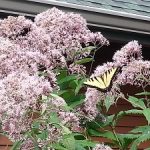
Joe-Pye Weed can grow to great heights and is a favorite of butterflies and other pollinators.
Carol Lampe shared these pictures and write up of her wondrous yard and the pollinator action on Joe-Pye Weed (Eupatorium purpureum). This is a particularly valuable fast food stop for migrating butterflies as it lasts into autumn. We have found it a bit difficult to start and then it takes off! Give it plenty of space and enjoy the butterflies.
“Here is a butterfly twofer from my flower bed. In the forefront you can see the female Eastern Tiger Swallowtail (Papilio glaucus) sitting on a Joe-Pye Weed. There were several Swallowtails out there that day.
“Joe-Pye Weed is an herb and the butterflies really seem to like it. Native Americans, and later, white settlers, made much use of Joe-Pye Weed. Teas of the roots or tops were used as a diuretic, as well as for rheumatism, gout, fevers, diarrhea, respiratory disorders, and even impotence. Modern science has not confirmed their efficacy.
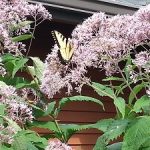
Sipping nectar on Joe-Pye Weed.
“Tucked toward the back is a Red Admiral (Vanessa atalanta). The males are territorial and many times can be found in the same location day to day.”
Thanks, Carol, for sharing your wondrous yard with Winding Pathways.
by Winding Pathways | Aug 8, 2016 | Bugs, Flowers/Grasses, Nature, Reflections/Profiles, Wonderment
Here is a story fro Gordon and Nancy Bena about their interest in Monarchs, their chrysalis find and how they began to tend their property differently to encourage insects.
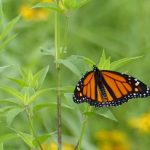
Adult butterflies need nectar to sip and plants to rest on.
“We went to the presentation given at the library that told us the fate of the Monarch. With that we were very careful not to mow down any Milkweed plant that we saw in the yard. We also planted Butterfly Weed and I did not mow any of the clover down this year.
“This particular plant where we found the chrysalis was kind of blown over from one of the wind storms and we put a tomato cage around it to hold it up so the caterpillars would have something to munch on. When I went down to get the mail the other day, I stopped to check that the plant was still standing. This is when I found the chrysalis. I went around to the other plants but I’m afraid that this is the only success story I found so far.”
Thanks, Gordon and Nancy!
by Winding Pathways | Jul 29, 2016 | (Sub)Urban Homesteading, Flowers/Grasses, Nature, Reflections/Profiles, Wonderment
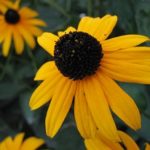
A brilliant harbinger of summer with a long lasting biannual bloom.
Many years ago word came that a dear friend had tragically died in Utah, over a thousand miles from our Iowa home. With deep feelings of grief of the loss of a vibrant young woman I (Rich) felt the need to “do something for her.”
We were in the process of restoring prairie to a bare patch of ground on recently purchased piece of land at the Indian Creek Nature Center. A bag of prairie wildflowers perched against my office wall caught my eye. I grabbed the bag, walked to the meadow and scattered the seeds in the woman’s honor.
The seeds thrived. Now, a dozen years later they grace the prairie with color and restore memories of my friend. We shared this story with our friend’s husband who was moved. So, we decided to share our way of honoring and memorializing ones dear to us.
Planting flowers, shrubs, and trees in a yard or park is an outstanding way to reduce grief, maintain memories, honor someone, and make our world healthier and more vibrant.
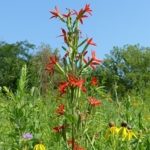
What a stunner!
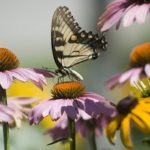
Sipping nectar
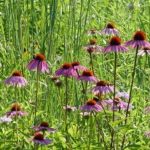
Purple Coneflowers add color to a prairie.
by Winding Pathways | Jul 26, 2016 | (Sub)Urban Homesteading, Flowers/Grasses, Garden/Yard, Nature, Reflections/Profiles, Wonderment
Periodically readers send lovely essays and observations of their Wondrous Yards. Below is a poetic piece by Katrina Garner.
“One of the benefits of creating and maintaining burn barriers around prairie areas is that the resulting “pathways” provide the perfect opportunity to observe the prairies from all sides. Every morning I head out with our Lab Schatzie for our long daily walk around the property, letting Schatzie choose our route. Sometimes she startles a deer, and sometimes a turkey blasts out of the grasses right in front of us. Schatzie holds on to the hope that one day she’ll actually catch one of the hundreds of rabbits who manage to stay just out of her reach. Always there’s a chorus of bird songs, blending together like a pastoral symphony, to remind me to focus on nature’s sounds.

Capturing the essence of prairie blooms.
“I have my phone handy in case I see the perfect view for a future landscape painting. One day this past week we were ending the walk along the path between our first prairie planting and the pollinator strip next to it. The house was above us beyond the prairie. Our farm is named “Himmelhof,” a phrase coined by a friend of ours as an approximate Austrian translation for “House in the Heavens.” Seen from many points on the property, the house does seem to “float” above the prairie, and I’m particularly fond of those views of the house. At this point in our walk, the coneflowers and Black-eyed Susans were plentiful and at their peak, so I took out my phone and framed my photo to capture the “floating house” with colorful flowers in the foreground.
“A few days later, going through the recent photos on a larger computer screen, I was startled to see what looked like a ballerina with her arms raised to the heavens and her face turned towards the sun. If I wished to be pragmatic, I would acknowledge the fact that “she” was a cup-plant (Silphium perfoliatum) just masquerading as a fairy ballerina. However, the romantic in me chooses to see my prairie ballerina fairy as a joyful, whimsical reminder that I should always keep my mind and heart open to the beauty of the nature around me.
Katrina Garner, July, 2016″
Keep sharing about your lovely spaces, folks! Thanks, Katrina.
by Winding Pathways | Jul 5, 2016 | Bugs, Children/Play, Flowers/Grasses, Nature, Wonderment
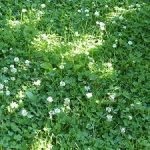
Soft and fragrant underfoot, clovers naturally fix nitrogen in our lawns.
A man whom Rich hadn’t seen for years recently approached him in a parking lot. “You once wrote a newspaper column suggesting that people not spray their yards for insects or weeds. We took your advice and magic happened,” he said.
He explained that a couple of years after he stopped spraying, white clover appeared in the yard and fireflies graced the evening darkness. “We’re enjoying both,” he added.
A major problem with poison sprays is that they aren’t usually selective. Often people spray to rid their lawn of grubs without realizing they also are killing fireflies, pollinators, and a host of other interesting and beneficial insects and the animals that dine on them. If you poison dandelions, you also kill clover that fixes nitrogen naturally and a wide range of other flowering plants that add diversity to the lawn and buffer it from unusual growing conditions.
FIREFLIES
What child has not delighted in chasing fireflies on a warm summer evening and, perhaps, catching a few to watch light up the inside of a glass jar? In fact, an adult friend who grew up on the eastern plains of Colorado was enchanted with them when she visited Iowa one summer. Fireflies, or lightning bugs, are common across much of the Eastern United States. Some blink yellow while others green, but whichever color they blink it is probably an effort to seek a mate. Some firefly species live in the West, they just don’t glow! The larvae, sometimes called glow worms often live in rotting wood where they seek insect prey.
To enjoy an evening firefly display leave edges and corners of your yards unmowed. Perhaps position some wood there to gradually rot and provide homes for their larvae. Certainly avoid insecticide spray!
CLOVER
Many species of clover are common across much of North America but the one most often found in unsprayed yards is the White Clover. It can be planted but usually just avoiding herbicides for a few years will encourage it to move in on its own. Clover blooms provide wonderful pollinator food while sprinkling a lawn with attractive white flowers. The plant is a legume, meaning that it is able to fix nitrogen and improve soil health – naturally! Why anyone would want to kill such a valuable and beautiful plant is beyond us.
Sometimes the very best lawn and yard management is simply leaving it alone. Stop spraying and the result is likely…….beauty.
by Winding Pathways | Aug 10, 2015 | Flowers/Grasses, Nature
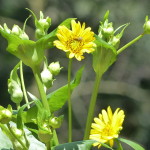
Late summer bloomers like cup Plant attract many pollinators.
One of the most interesting wildflowers has a long blooming season from mid-summer until early September and is host to a vast diversity of wildlife.
The Cup Plant (Silphium perfoliatum) gets its name from cups that form along the square stem of this large Silphium. Heavy dew and rain channel down leaves and stems to collect in the small cups of the leaves that gather around the stalks (perfoliatum) where birds and insects sip the moisture. This plant is nature’s watering hole, but it does even more to attract wildlife.
The showy flowers are sunflower-like and their brilliant color reflects the late summer hues of male goldfinches. This bird loves cup plants, where it drinks water, snacks on insects attracted to it and later in the fall eats the seeds. When in bloom cup plants are loaded with pollinators. Bumblebees and yellow and black swallowtail butterflies are frequent guests.
Cup plants live from the Great Plains east to the Atlantic and usually can be found in moist soil on the edge of woods. They thrive in yards but beware! This plant can grow to be ten feet tall. They are easily propagated from roots and tend to spread.
We have a big clump of cup plants near our back deck at Winding Pathways and enjoy watching a never ending stream of insects and birds visit the blooms. They are tall and block vision, so when the last seed is gleaned by an autumn goldfinch we cut down the stems but look forward to next year’s regrowth.










